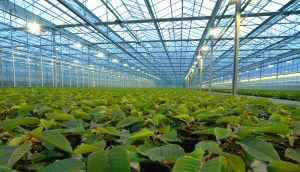
As any good greenhouse production consultant, greenhouse extension agent or land grant university will tell you . . . efficient, thorough and effective Greenhouse Sanitation Programs is necessary in order reduce your exposure to insects, disease, bacteria, viruses and possibly viroids. A well thought out program will also improve your fruit and flower quality while at the same time reduce your need for pesticides, excess labor and un-needed worries.
Items to focus on:
1) The previous crop may be still harbouring active sporulating infections
such as but not limited to powdery mildew. There may also be strains of disease that
have become resistant to the fungicides that may have been used on
the crop over the season.
2) The use of knives spreads viral infections such as green mottle
mosaic virus. It is imperative to adopt a regular disinfection procedure
to break the cycle of infection.
3) Harvest trays should be regularly cleaned and disinfected. They are
a constant source of disease transmission and should be cared for.
4) Clothing and footware – nursery staff will generally be aware of the
need to wear clean clothing in the greenhouse but is there a policy
in respect of visitors to the nursery?
5) Hands – Mycosphaerella is often spread by unclean hands.
Ensuring that staff practice regular personal hygiene is essential.
6) Polythene and rockwool materials (and/or other substrates and containers) will be covered in spores at the
end of the season. The use of a disinfectant and steam sterilisation will
deal with these infection sources.
7) Irrigation tubing and drips. Buying new irrigation equipment every
year is not a viable option but regular disinfection of the system is.
And …
♦ Post-harvest: pre-crop pull out – Once the final harvest has been
taken from the crop and before the vegetation is removed from the
glasshouse, the use of a disinfectant removes possible resistant
strains of pathogens that may have built up during the growing cycle.
Greenhouse disinfectants at the labeled rates over the senescing vegetation so that
when pull-out occurs the spread of fungal spores is minimized.
♦ Intercropping situations – Disinfectants can be used in backpack sprayers
sprayer for spot treatment to clean down these areas.
♦ Irrigation lines – Used labeled products and leave for 1 hour
before flushing the system with clean water.
♦ Resistance – Is not a problem with Greenhouse Disinfectants owing to their unique and
rapid activity. And therefore are key element in an anti-resistance
strategy.
♦ Biological systems – Most fit as key parts of IPM strategy.
Contact Hort Americas if you would like to continue learning more about Greenhouse Disinfectants!
Visit our corporate website at https://hortamericas.com



